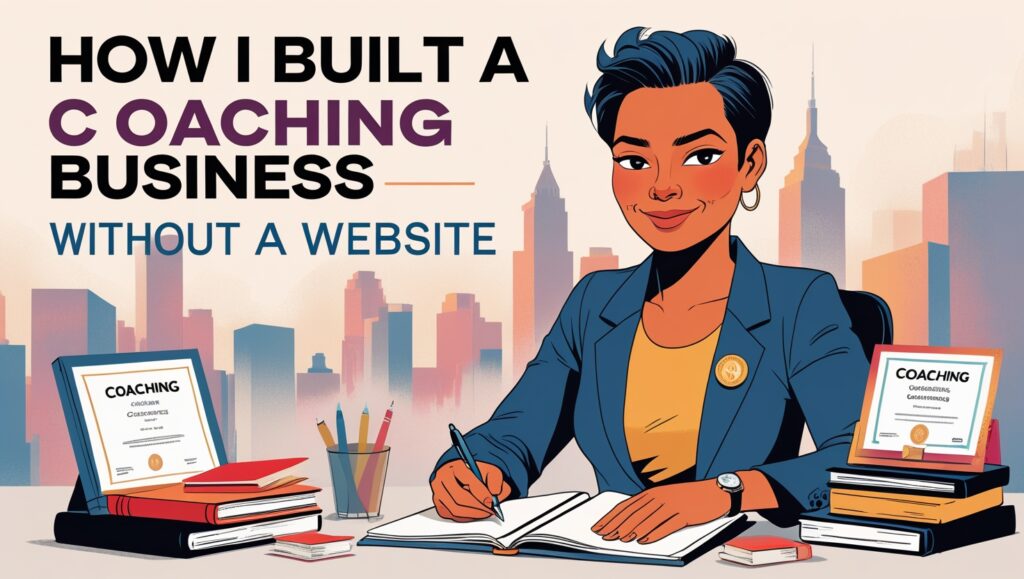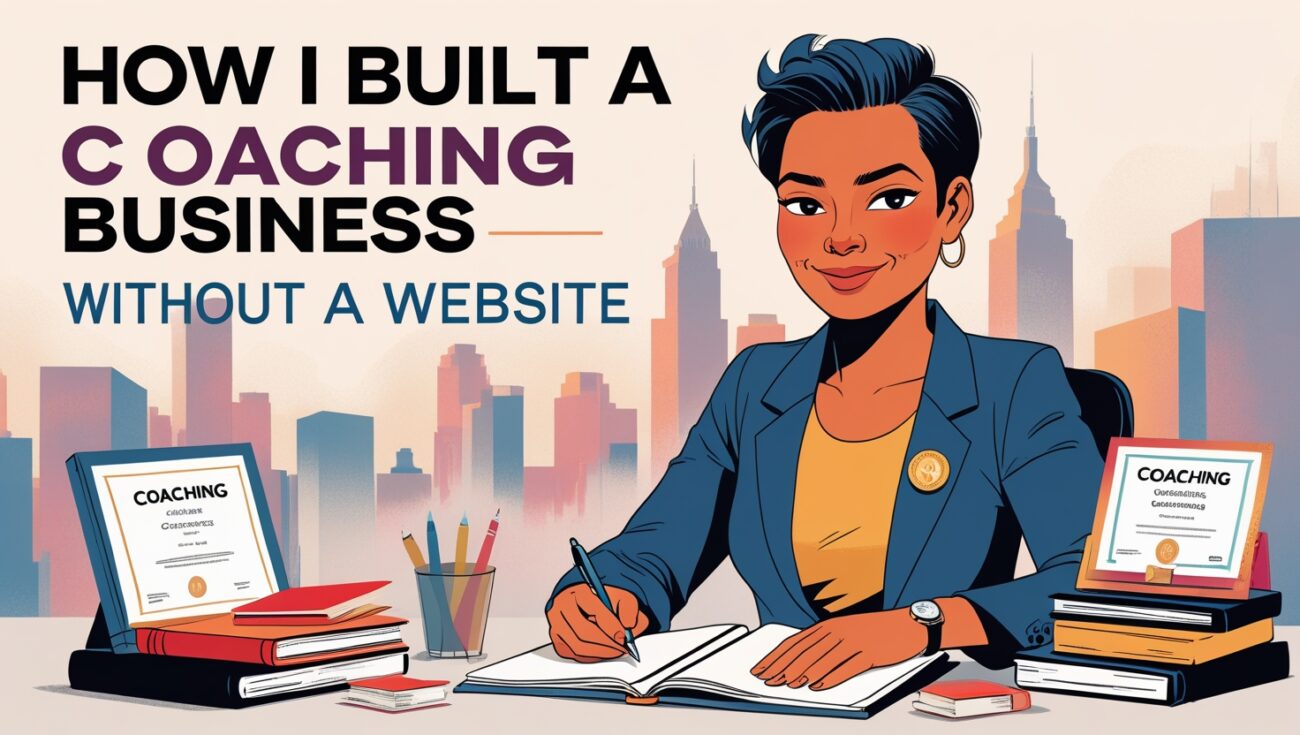How I Built a Coaching Business Without a Website
When I first started coaching, I thought I needed a beautiful website, fancy branding, and a ton of content before I could get clients. That belief kept me stuck for months. I wasted time tweaking logos and worrying about colors instead of focusing on what actually brings in clients.
The truth is you don’t need a website to build a successful coaching business. I built mine using a few simple tools and a clear process — and I’m going to show you exactly how I did it.

Table of Contents
Why You Don’t Need a Website to Start
Websites are great for later, but in the beginning they can be a distraction. They take weeks (or months) to build, cost money, and don’t guarantee you’ll get any clients.
What you actually need is:
- A clear offer
- A simple way for clients to connect and pay you
- A place to deliver your coaching
That’s it. And the best part? You can do all of this without a website.
Step 1: Build a Clear Offer
Before I worried about anything else, I asked myself: What specific result do I help my clients achieve?
If your offer isn’t clear, no website can save you. I focused on solving one big problem for a specific group of people. This made my messaging stronger and helped me stand out, even without a website.
Step 2: Use Skool as My Home Base
Instead of building a website, I used Skool as my hub. Skool allowed me to:
- Host my community where clients could connect
- Deliver my lessons and resources in an organized classroom
- Schedule live coaching calls on the calendar
- Collect monthly or one-time payments through Stripe
If you want to build your coaching business without a website, sign up for Skool here: click here to get started.
With Skool, I had a professional-looking space for my clients, and I didn’t have to worry about coding or web design.
Step 3: Get Clients Through Direct Outreach
Since I didn’t have a website, I relied on direct outreach to get my first clients. I posted valuable content on social media, reached out to people who engaged, and offered free discovery calls.
The key was to focus on relationships instead of trying to drive cold traffic to a website. This allowed me to build trust faster and sign clients even with a small audience.
Step 4: Deliver Incredible Value
Because I used Skool as my coaching platform, I was able to deliver a premium experience without any extra tools. Clients could access recordings, ask questions in the community, and connect with each other.
The more value I delivered, the easier it became to get referrals and testimonials — which fueled my growth even more.
Step 5: Create a Simple Payment Process
Instead of complicated checkout pages, I used Skool’s built-in Stripe integration to handle payments. Clients could sign up and pay instantly, and their access to the coaching group was automated.
This saved me hours of admin work and made the client experience seamless.
Why This Works So Well
Most new coaches think they need a polished website to look legitimate. But clients don’t care about fancy pages — they care about the results you can help them achieve.
By skipping the website and using Skool, I was able to start faster, sign clients sooner, and focus on what matters: coaching and growing my business.
What You Should Do Next
Here’s the exact process you can follow:
- Sign up for Skool here and create your coaching group
- Clarify your offer and the results you help clients achieve
- Post valuable content on social media to build trust
- Invite potential clients into your Skool group and book discovery calls
- Deliver value and keep your clients engaged
You’ll be amazed at how quickly you can build momentum without spending months on a website.
Final Thoughts
A website can be a nice-to-have later, but it’s not required to start. You can build a full coaching business without a website using Skool as your home base.
Don’t wait another month trying to build the perfect site. Sign up for Skool here: click here to launch your coaching group now.
Your clients are waiting for you to show up and help them — you don’t need a website to start.
When I first made the decision to skip the website, I was nervous. I thought clients might not take me seriously. But what I discovered is that clarity and results build credibility, not a fancy site. As soon as I got clear on who I help and how I help them, clients started signing up without asking if I had a website.
Another benefit of not having a website at the start was speed. I didn’t waste months designing pages and figuring out tech. I launched my coaching offer in days instead of months, which allowed me to start earning income quickly.
If you want to avoid delays and start fast, sign up for Skool here: click here to create your coaching group now. This one decision could save you months of frustration.
I also realized that a simple, professional Skool group looks more polished than a half-finished website. My clients loved logging in and seeing a dedicated space just for them, with lessons, a calendar, and a community feed all in one place.
If you’re wondering how to find clients without a website, the answer is relationships. I started by making a list of people who had already shown interest in my content and reached out personally. These warm leads were far more likely to become paying clients than strangers visiting a website.
Another tip is to share valuable content consistently on social media. This builds trust and positions you as an authority. When you invite people into your Skool group, they already know who you are and what you offer.
The reason this method works so well is because it’s focused on action, not perfection. Too many coaches waste time perfecting details that don’t matter. The sooner you start inviting people into your paid coaching offer, the faster you’ll grow.
Here’s exactly what you should do next:
- Sign up for Skool here
- Name your coaching group and add a welcome message
- Upload your first resource or training
- Reach out to at least 10 people in your network and invite them to join
I can’t stress enough how powerful this simple process is. You don’t need to complicate things with fancy websites or funnels. Just start, and build as you go.
Another advantage of this method is that it’s scalable. As your coaching business grows, you can add more features to your Skool group, increase your prices, and even build out premium tiers — all without starting from scratch.
Finally, remember that clients care about results, not design. If you focus on helping people achieve the outcomes they want, you’ll build a reputation that no website could ever match.
Don’t wait any longer. Click here to sign up for Skool and launch your coaching business this week. This step will give you the momentum you need to start earning and growing without wasting time.






